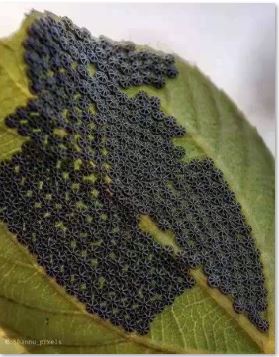
Recently, I noticed strange black geometric patterns covering the leaves in my garden and initially feared they were signs of a harmful infestation. To my surprise, they turned out to be the eggs of the Mourning Cloak butterfly (Nymphalis antiopa). These eggs are laid in clusters, creating intricate lace-like designs across the leaves. Each egg is perfectly shaped, forming a delicate and mesmerizing geometric pattern — a small masterpiece of nature hidden in plain sight.
When the eggs hatch, tiny black caterpillars with white spots and spiny bodies emerge. They prefer feeding on the leaves of willows, elms, and poplars rather than flowers or vegetables, meaning they pose no threat to typical garden plants. As they grow, the caterpillars go through several molting stages before forming a chrysalis, eventually transforming into stunning Mourning Cloak butterflies.
These butterflies are easily recognized by their deep brown wings edged with yellow borders and dotted with blue spots. They are among the first butterflies to appear in spring, often after hibernating through winter, symbolizing the arrival of warmer weather. Their presence adds natural beauty and ecological balance to any outdoor space.
If you encounter these eggs or caterpillars in your garden, it’s best to leave them undisturbed. Mourning Cloaks play a valuable role in supporting biodiversity and maintaining a healthy environment. Watching their transformation — from egg to caterpillar to butterfly — offers a powerful reminder of nature’s resilience and the quiet wonders thriving in our own backyards.